MXA RACE TEST: THE REAL TEST OF THE 2024 KTM 450SXF
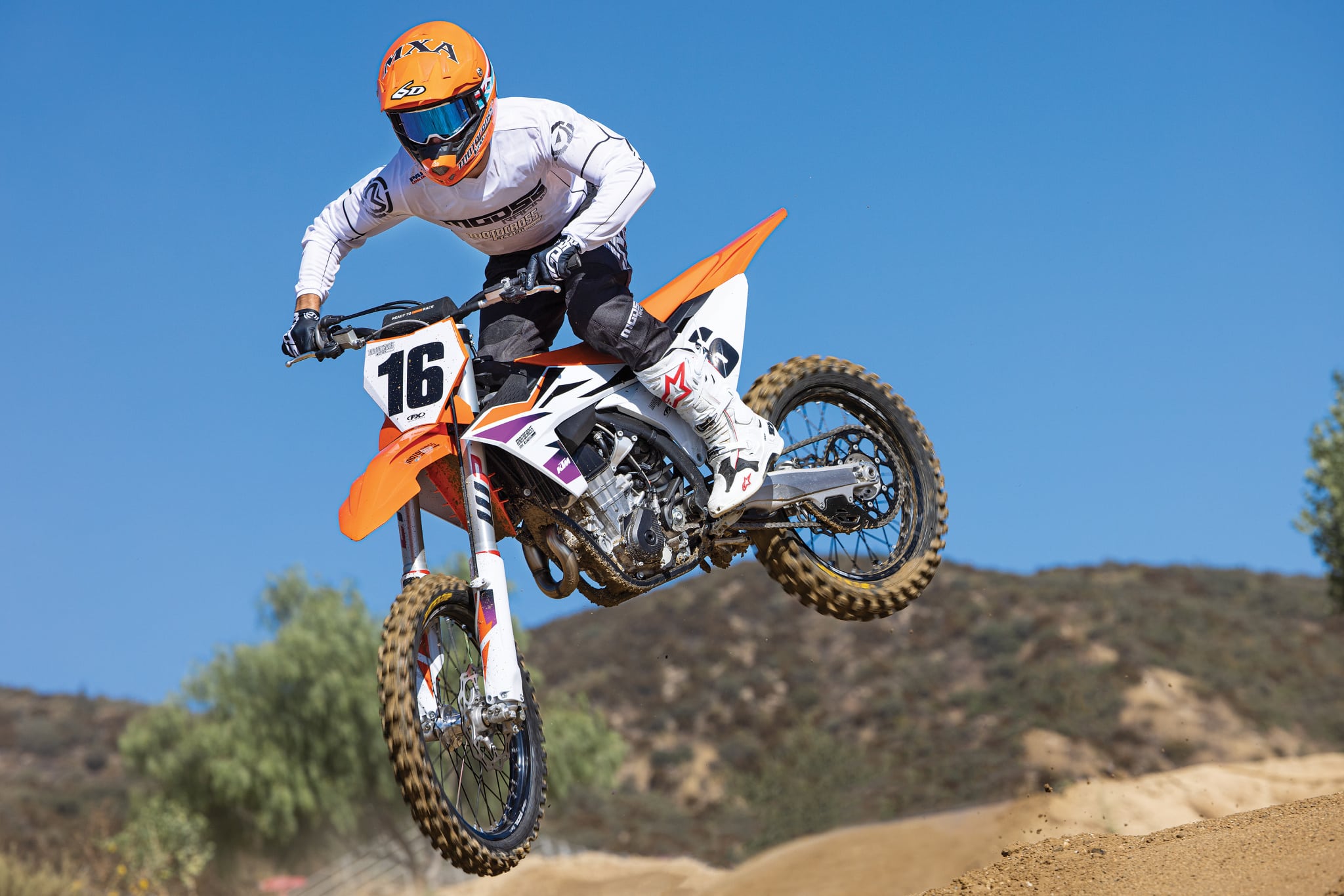
Q: FIRST AND FOREMOST, IS THE 2024 KTM 450SXF BETTER THAN THE 2023 450SXF?
A: Yes and no, but mostly no—although, most of the good stuff remains, but paradoxically, some of the bad stuff remains unchanged.
Q: IS THE 2024 KTM 450SXF JUST A BNG BIKE?
A: Of course it is a BNG bike. How unrealistic would it be for a consumer to expect KTM to build a whole new bike for 2024 when they changed literally every singe part of the 450SXF just 12 short months ago. By the same token, it is equally out of the question to expect Yamaha to build a completely revised YZ450F for 2024, and certainly, there is no expectation of a new Suzuki RM-Z450.
KTM has been one of the most aggressive manufacturers when it comes to updating their machines. The Austrians do not live by the four-year production cycle like most of the Japanese brands; KTM makes changes in a much shorter cycle and almost always when issues arise that demand their attention.
Q: WHAT WAS ALL NEW ON THE 450SXF IN 2023?

A: The KTM 450SXF was the most technically advanced motocross bike on the track in 2023, which is why KTM is not compelled to produce an updated version for 2024. From its bodywork to its electronics to its ergonomics to its power to its overall design, it was cutting edge.
Here is the short list of what KTM changed for the 2023 model year: The chromoly frame was redesigned from the triangulated steering head tube to the separated shock tower. In short, the 2023 frame was designed to be stronger up front and less likely to transfer bump energy up the frame’s backbone.
The all-new engine was tilted 2 degrees rearward and moved down 3mm to lessen the 2022-and-earlier KTM’s tendency to squat under hard acceleration. There was a new airbox designed with massive air vents and a new hybrid aluminum/polyamide plastic airbox structure to improve engine breathing.
There was a new cylinder head and gearbox. The electronics received lots of attention. Not only was there more responsive power, but the engine delivered the broadest powerband in the class. There were two new maps—the “white light” button produced an easy-to-use powerband that offered all-around power, while the “green light” map had more hit and a quicker rev. Additionally, the electronic suite came with traction control, launch control and Quickshift, which offered clutch-less upshifts from second to fifth gears.
The WP XACT forks came with new settings in 2023, including a Hydrostop bottoming control system and a completely redesigned WP XACT rear shock that featured easy-to-use low- and high-speed compression dials that could be tuned by hand without the need of any tools.
Not enough good stuff can be said about KTM’s hydraulic Brembo brakes and Belleville-washer-controlled Brembo clutch, both of which have been adopted by their Japanese competition.
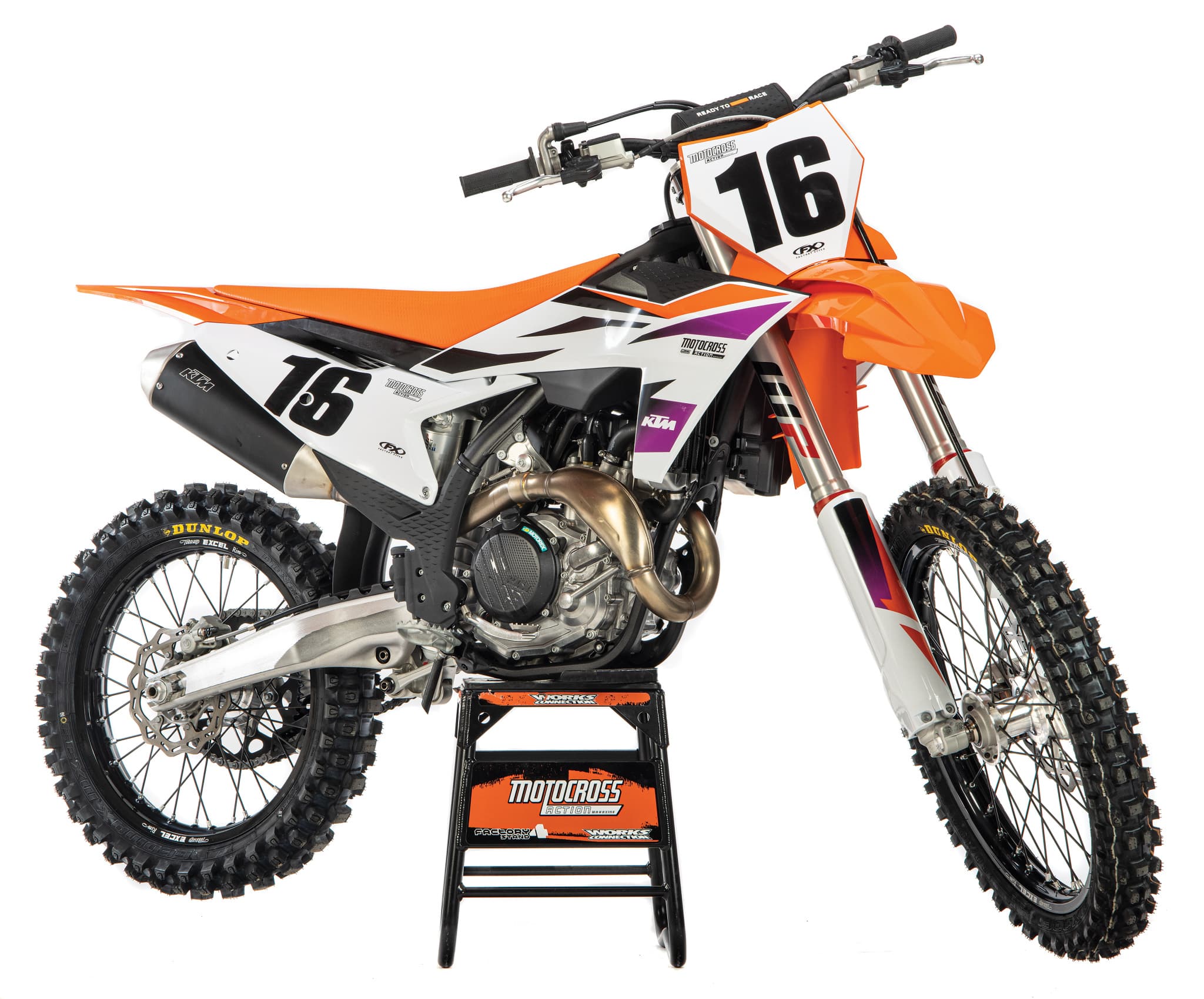
Q: SO, WHAT DID KTM CHANGE ON THE 2024 450SXF?
A: That’s simple. There are only three things that are different, and one of those came on the early-release 2023-1/2 KTM 450SXF Factory Edition. Here they are:
(1) Bold new graphics. In truth, there is nothing bold about that splash of purple on the radiator shrouds, but visually it is the only thing that makes a 2024 model easy to recognize when sitting next to the 2023 version. The MXA test riders have better things to complain about than the color purple; it’s not like it is being billed as the “Oprah Winfrey Edition.”
(2) MSRP. A couple of months ago KTM was blowing out left-over 2023 KTMs, Huskys and GasGas’ for bargain-basement prices for an almost identical bike that they are now offering at an MSRP of $11,099.
(3) Suspension. Although the 2024 suspension setup is very different from what came on the 2023 KTM 450SXF base model, it is the exact fork and shock off of the 2023-1/2 KTM 450SXF Factory Edition. 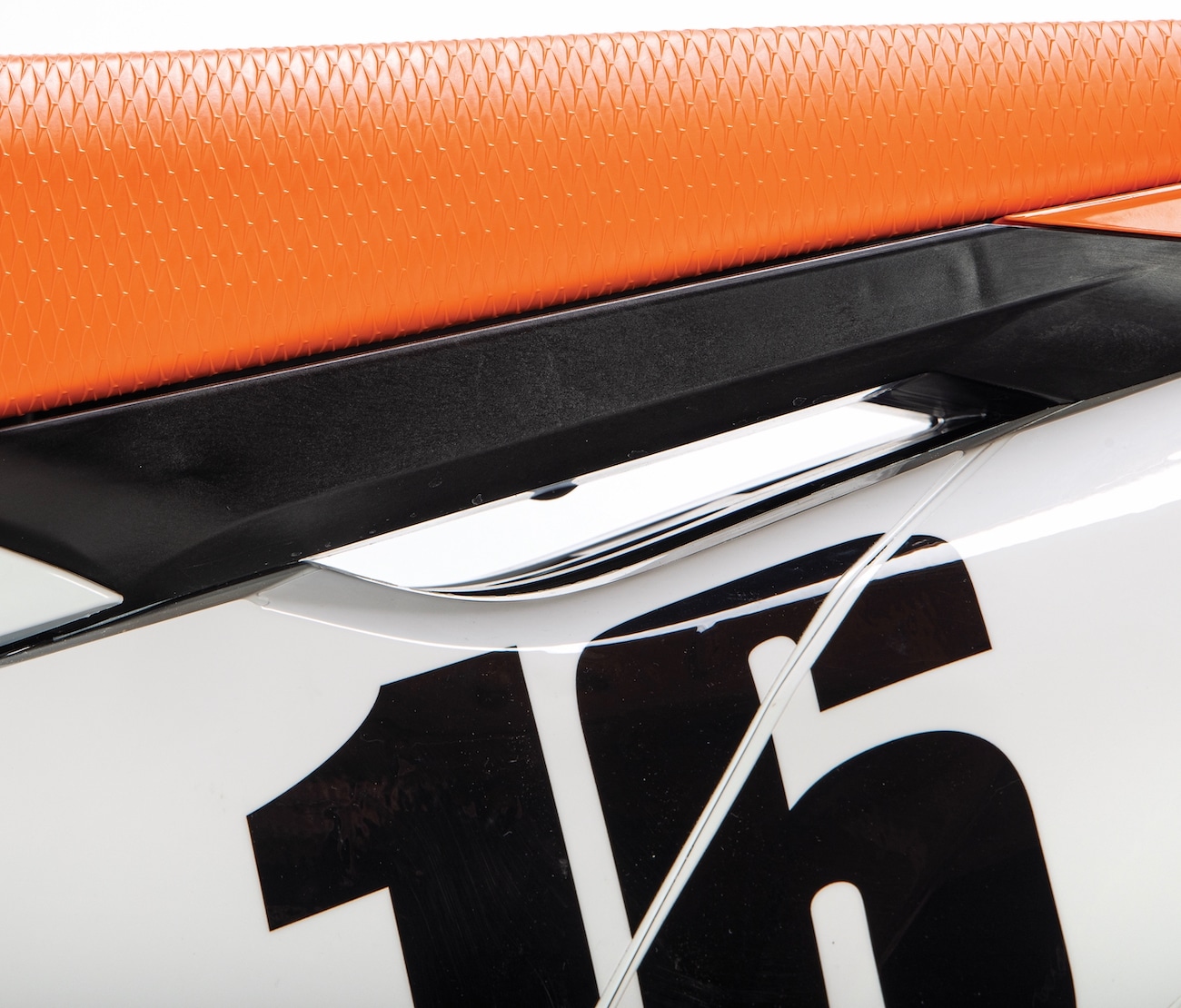
Q: HOW GOOD IS THE NEW AIRBOX DESIGN?
A: Unlike in previous KTM model years, all of the air coming into the 2023–2024 airbox is routed through large vents on each side of the airbox. The vents are positioned above and behind the air filter, and are aided by a V-shaped dome under the seat base to help redirect the air in a downward direction. It is a vastly improved airbox in terms of volume and air ingress, and KTM offers an optional vented airbox cover for those who want increased throttle response.
The stock Twin Air air filter is incredibly easy to install. It plugs into rubber grommets behind an easy-to-remove airbox cover sans tools.
Q: HOW DOES THE 2024 KTM 450SXF RUN ON THE TRACK?
A: MXA always criticized the pre-2023 KTM 450SXFs for being down on power as it worked its way towards its impressive mid-to-top spread. It was too mellow from low to mid! No more. The new 2023–2024 engine accelerates much harder out of corners and keeps on pulling into the top-end.
The power, from top to bottom, is delivered in one long, churning locomotive style of power. It builds at an unbelievably progressive rate from 5000 rpm to its peak at 9400 rpm. It makes an impressive 59.94 horsepower at peak.
Q: WHAT’S NEW ON THE 2024 WP XACT SUSPENSION?
A: WP reworked the forks and shock for the 2024 450SXF with the goal of increasing comfort and adjustability at both ends. Both the shock and fork valving are different from the 2023 production KTM 450SXF, but the changes are limited to specific segments of the stroke in places where WP felt they could make the suspension less finicky to setup changes.
Forks. WP says they made “minor refinements” to the compression shim stack to make the mid-valve damping feel more fluid and comfortable. They did not touch the rebound side of the fork’s damping, nor are there any alterations to the suggested air pressure or clicker settings—just that the rider should be willing to fine-tune the feel by making clicker adjustment based on track conditions.
Shock. The WP technicians, with the help of KTM’s American R&D crew, developed new high-speed compression damping settings because they felt that the 2023 settings had too big of a gap per adjustment. The goal was to get the high-speed compression dial to make smaller adjustments per dial movement. WP made incremental changes to reduce the damping effect per click by 50 percent.
That meant the movement of the 2024 high-speed compression dial allows the riders to fine tune the compression changes in smaller increments. On the 2023 stock shock, it was easy to go too far with each adjustment. On the 2024 450SXF, there is more room to find better settings. How did WP get the adjuster to make smaller changes without changing the shock design? That was the easy part. The 2023 WP shock had 15 high-speed compression shims, while the 2024 shock has 23 shims The increase in the shim stack made each adjustment smaller and offered the rider twice as many options.
Q: WHAT DO YOU HAVE TO DO TO LIVE HAPPILY EVER AFTER WITH WP AIR FORKS?
A: KTM has been fighting an uphill battle to gain acceptance for air forks. No surprise, back in 2010 they faced the same outcry of public opinion against their singled-sided, single-shock, no-link rear suspension. And, just like today, KTM didn’t want to change it, but they did and reaped the benefits of not having to defend something that the consumer didn’t believe in.
Does that means that KTM should drop the WP XACT air forks? No, but it needs to do a much better job of educating the buying public on how to live and love air forks. The MXA wrecking crew likes the WP XACT air forks, and it is a little-known fact that both Aaron Plessinger and Cooper Webb (when he was still racing) ran stock 48mm WP air forks on their works bikes in the 2023 AMA 450 Nationals. It should be noted that on its 2024 off-road models, KTM installed coil-spring forks based on their WP 6500 conversion kit.
What does it take to make the KTM XACT air forks work? First, the racer has to understand that the air pressure is just a replacement for the coil spring. It does not do anything else. Once you find the proper air pressure for your speed, weight and local track, you are halfway home. The other half is to use the compression and rebound clickers to fine-tune the overall feel.
Yes, air forks do require you to check the air pressure at the start of the day, bleed excess air from the outer chambers regularly and reset the air pressure if the temperatures rise or fall, but those are things you should also be doing to your bike’s tires. Air forks save over 3 pounds of weight—and that is a benefit of epic proportions.
Q: WHAT IS THE BIGGEST DOWNSIDE OF AIR FORKS?
A: There is one annoying caveat to how the 2023 WP forks work and that is that they don’t work very well for the first couple hours. The WP forks are set up from the factory with tight tolerances. This is good for the long haul, but not so sweet in the short run. We want to warn you that your first ride on the WP XACT AER air forks will be the worst ride of your life. Husqvarna, KTM and GasGas forks come off the assembly line very stiff for the first few hours of riding. Test riders who raced the bike at two hours of run-time hated it, but two weeks later, when the forks had four hours on them, the exact same test riders, on the exact same bike, on the exact same track, loved them.
Don’t judge the 2023 KTM 450SXF forks by the first couple of hours on them. Take the time to break them in. They will get better with each ride, and you’ll be happy with them once they have five hours on them.
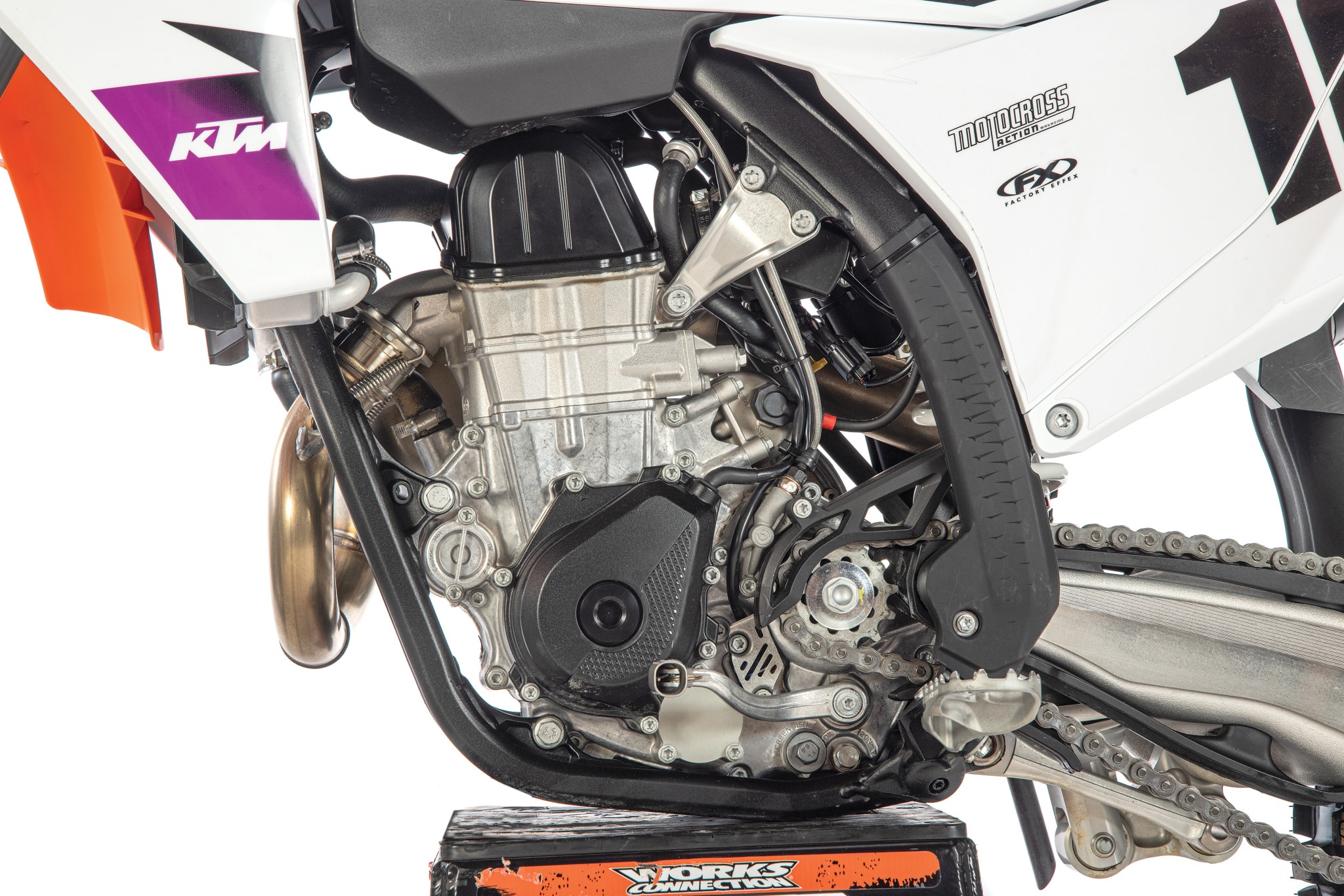
Q: WHAT ABOUT THE WP REAR SHOCK?
A: Thanks to the new frame, the rear shock and shock spring are 15mm shorter. KTM’s goal was a better overall packaging to fit with the new shock tower design and revised shock linkage, which has its pivots moved up to raise the link arms farther off the ground. Additionally, the new shock/spring combo saves 100 grams (3.5 ounces). Even though the shock and spring are shorter, the shock’s stroke is unchanged from 2022, and the spring rate is still 45 N/mm.
One issue that plagued MXA test riders was that on hard landings, the shock would bottom—hard! We surmised that the rising rate at the end of the stroke needed to be stiffer. Pro Circuit and AEO both make aftermarket links that make the WP shock softer initially and stiffer at the end of the stroke‚ which is the exact opposite of the stock KTM shock linkage. If you don’t want the added expense of the aftermarket links, try more low-speed compression damping to help with hold-up, or send the shock to your favorite tuner and have him focus on more compression damping in the last 25 percent of the shock’s travel.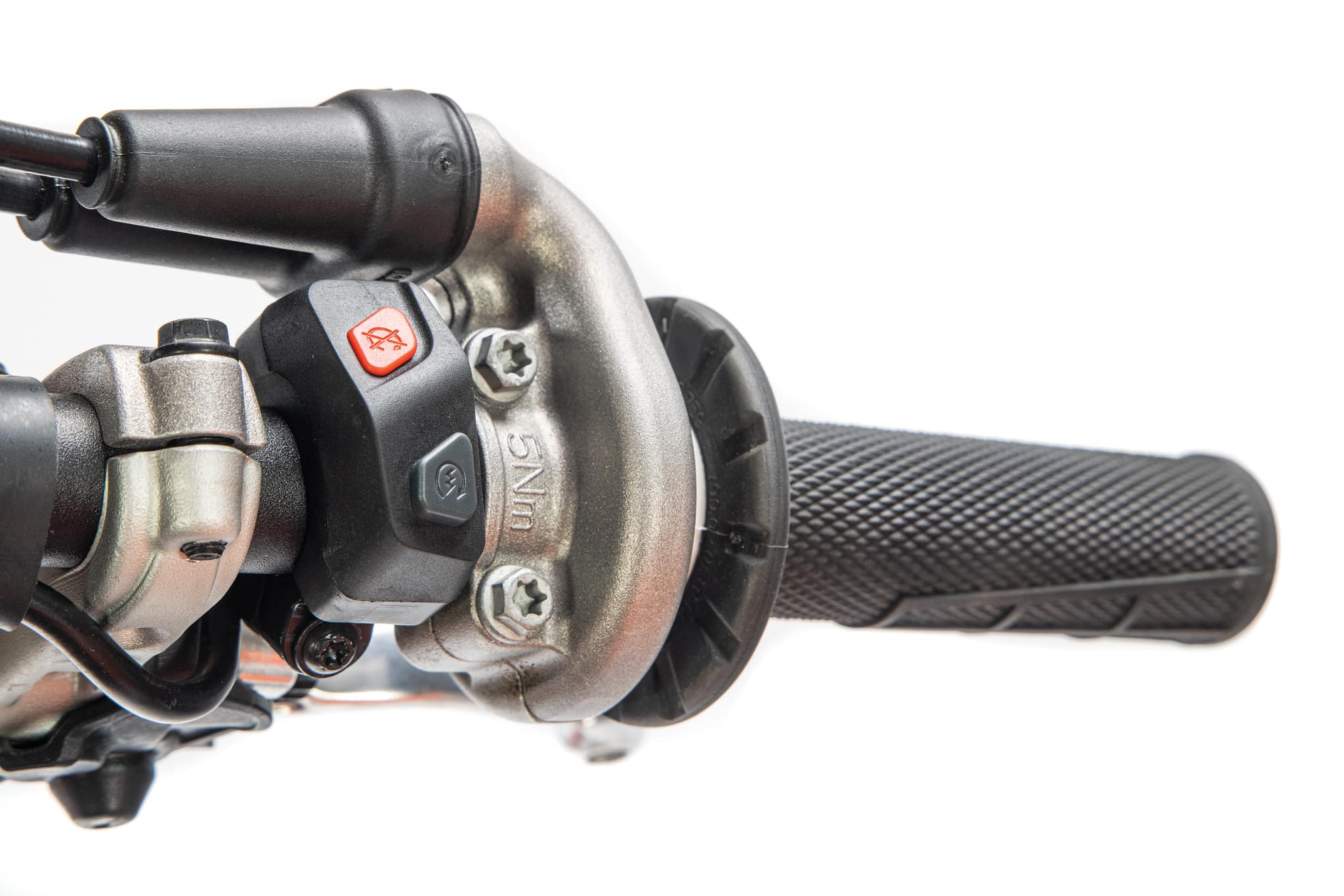
KTM sealed the start/stop switch for 2024.Q: HOW DOES THE 2024 KTM HANDLE?
A: It feels identical to the 2023 KTM 450SXF after the requisite 10 hours of break-in time. Unlike the forks, which break in relatively quickly, KTM’s chromoly chassis doesn’t loosen until some time between 8 and 10 hours of ride time. Why? KTM engineers went to great lengths to make the frame stronger and more rigid, especially in the head-tube area—even to the extent of mounting the engine to the frame without using motor mount plates.
Ten hours may sound like a ridiculous amount of break-in time, but that’s because it is! This is a flaw of KTM’s own making by trying to design a frame for pro riders instead of everyman buyers. You should, however, understand that the chassis will feel better every time you ride it. You’d be amazed how many first-time KTM owners waste money on expensive fork mods and shock springs when all they really had to do was ride it more.
The MXA test riders like the way the 2024 KTM 450SXF feels in motion. Yes, it is 5 pounds heavier than it was in 2022, but it is still lighter than any Japanese-built 450. Additionally, KTM borrowed the anti-chain torque theories of Horst Leitner and Eyvind Boyesen, who discovered that rear-end squat (the tendency of the rear suspension to drop under acceleration was a byproduct of the bike’s chain line as determined by the angle the chain follows from the rear sprocket to the countershaft sprocket). Changing the chain line, by either raising the swingarm pivot on the frame or lowering the countershaft sprocket on the engine, greatly reduces squat. The 2022 KTM 450SXF had squat issues, most evident in consecutive whoops, but by rotating the engine backwards, KTM was able to lower the countershaft sprocket by 3mm, which lessened squat under acceleration by reducing chain torque. You can feel the improvement in rear-wheel traction.
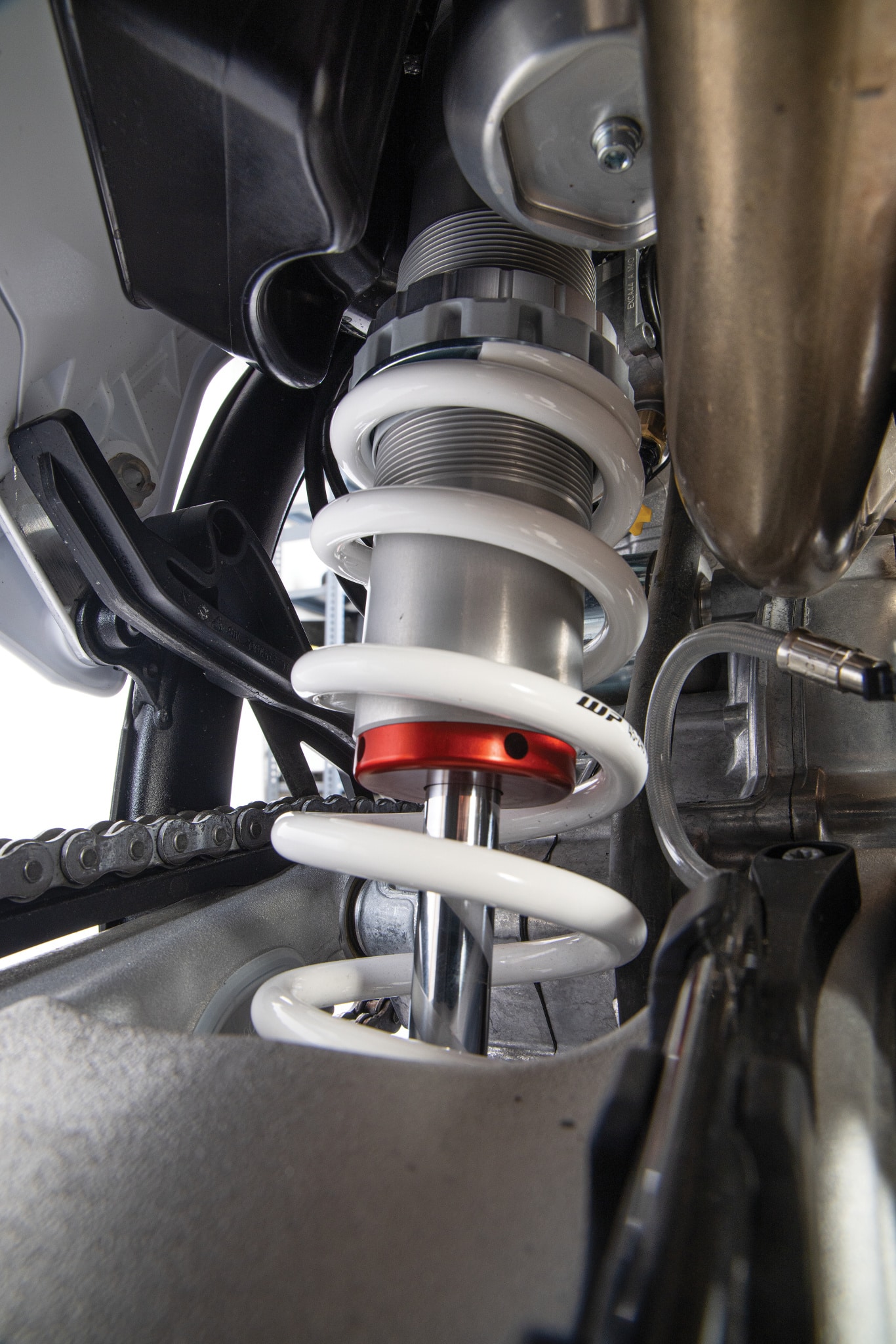
Q: WHAT DID WE HATE?
A: The hate list:
(1) Start/stop buttons. Never spray the start/stop switch with a power washer, especially on the 2023 KTM 450SXF. Water could get inside the switchgear last year and short out the ECU. KTM sealed the 2024 switch box better and claims that the issue is behind them. If you don’t like having the kill button on the right side of the handlebars, Nihilo Concepts makes separate start and stop buttons that retro-fit so you can put the kill button back on the left side.
(2) Seat height. It is skyscraper tall. If you don’t have long legs, your boots aren’t going to touch the ground.
(3) Chain slack. We’ve never checked chain tension with four fingers at the back of the chain buffer pad on any bike in the past, but on the 2023–2024 KTM 450SXF, you need 70mm of slack. If you don’t have 70mm, the chain will eat the front edge of the chain buffer pad (up by the countershaft sprocket). Keep an eye on the lower chain pad also. The chain is not right if it doesn’t look too loose.
(4) Brake-petal tip. It gets crushed, bent, or broken in any crash or collision you have. There are much stronger aftermarket tips available.
(5) Wheel spacers. Unlike on the last 20 years of KTMs, you cannot run your older spare rear wheel on the 2023–2024 models without changing the seals and spacer tube. Nacstar (www.nacstar.com) makes retro-fit wheel spacers that allow older-model wheels to fit on the 2023–2024 KTMs. They retail for $14.95.
(6) Finding neutral. Getting the transmission into neutral on the starting line is very hard. We rev the engine with the clutch pulled in, and when the rpm peaks, we snick the shift lever into neutral before the before the rpm drops.
(7) Gas cap. The gas cap sticks—sometimes to the extent that you can’t get it off at the gas station
(8) Spokes. KTM’s spokes come loose all the time. If you can’t check all the spokes, be sure to check the spokes closest to the rear rim lock; if those spokes are loose, you need to tighten all the spokes.
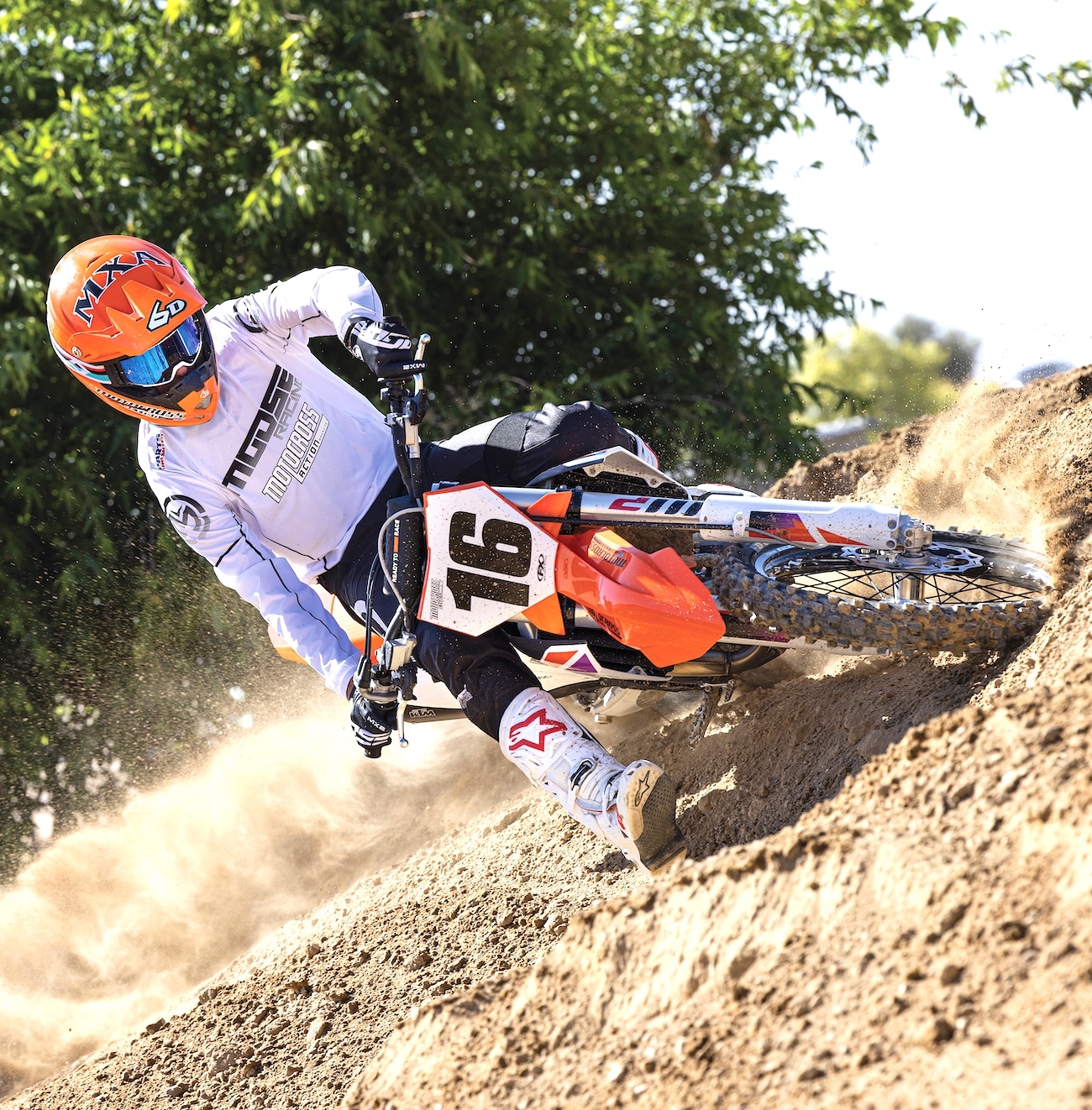
Q: WHAT DID WE LIKE?
A: The like list:
(1) Quickshift. It’s great for long, high-speed starts, but can be quirky in half-throttle situations. KTM says that you can turn it on and off on the fly, but given the position of the Quickshift button, you’ll be risking your life to try to find it at speed.
(2) Wider front fender. The 2023–2024 front fender is 1 inch wider and comes with four 1-inch winglets on the back half of the fender to widen the rear of the fender without cutting down on airflow to the radiators. It is a very heavy front fender, and the narrower and lighter 2022 front fender will fit.
(3) Map 2. A great map. It is smoother off the bottom with reduced engine braking and very linear power that takes off in the middle and goes until the blood rushes out of your brain.
(4) Airbox cover. It has a handle molded into the upper front corner that makes it easier to get the cover off. Plus, KTM has an optional vented airbox cover that improves throttle response.
(5) Idiot light. In 2022, the FI diagnostic’s LED light fell out of its holders constantly. In 2023, the idiot light was moved to the hour meter.
(4) Washing. The giant air vents below the seat are hard to seal off when you pressure-wash your bike. We run Twin Air’s plastic airbox covers to avoid getting water in the engine.
(5) Frame guards. The two problems with the stock KTM frame guards are that the thickness of the plastic pushes your feet outward (if you remove them, you will be surprised by how much narrower the bike feels at your boots), and the frame guards also stop you from easily checking the tightness of your swingarm pivot bolt, which has been known to come loose.
(6) No-tools clickers. You can adjust the WP shock and forks without ever using a tool. Low-speed compression, high-speed compression, shock rebound, fork rebound and fork compression are all adjusted by hand. The rebound clicker on the bottom of the shock is blocked by the linkage arms, but it has a slot for a flat-bladed screwdriver.
Q: WHAT DO WE REALLY THINK?
A: Once this bike is broken in, it is a thing of beauty. It has a luscious powerband, and even though it makes almost 60 horsepower, it is super manageable. It handles like a dream. No oversteer, no understeer; it is super accurate in all situations.
MXA’S 2024 KTM 450SXF SETUP SPECS
This is how we set up our 2024 KTM 450SXF suspension for racing. We offer it as a guide to help you find your own sweet spot.
WP AER FORK SETTINGS
There is a learning curve to getting the most out of the WP XACT air forks. The KTM WP XACT air fork has one Schrader valve to put air in or take air out. The right fork leg is strictly damping, and the left leg is air only. KTM has a sticker on the air leg to guide you to the recommended air pressure. It is a good starting point, but it’s just a suggestion, not an ironclad law. MXA has test riders who run as much as 165 psi and test riders who run as low as 135 psi. The 2024 forks have the potential to be great. For hard-core racing, we recommend this fork setup for an average rider on the 2024 KTM 450SXF:
Spring rate: 158 psi (expert), 152 psi (intermediate), 145 psi (vet), 138 psi (novice)
Compression: 14 clicks out (12 clicks out)
Rebound: 15 clicks out (18 clicks out)
Fork-leg height: Third line
Notes: The 2024 KTM 450SXF comes with rubber rings on each leg to allow the rider to see how much travel he is getting at a given pressure, but the orange rings wear out and slide down by themselves after a couple of hours. We run a zip-tie on the right leg to measure fork travel, which is an indicator of whether you have too much or too little air pressure.
WP SHOCK SETTINGS
Most MXA test riders liked the overall feel of the WP rear shock, especially after KTM lowered the shock spring rate in 2017 from 48 N/mm to 45 N/mm. WP did make some technical changes to the 2024 shock to make high-speed compression damping less finicky. We run the low-speed compression on 15 clicks out, the high-speed compression 1-1/2 turns out, the rebound on 15 clicks out and set the sag at 105mm. For hardcore racing, we recommend this shock setup for the 2024 KTM 450SXF:
Spring rate: 45 N/mm (for 175-plus pounds), 42 N/mm (for riders under 175 pounds)
Race sag: 105mm
Hi-compression: 1-1/2 turns out
Lo-compression: 15 clicks out
Rebound: 15 clicks out
Notes: When we have doubts about the shock’s compression damping, we focus on changing the high-speed compression, not the low-speed. We also choose to run the Pro Circuit KTM shock linkage. Unlike the stock linkage, which starts out stiff and gets softer as it goes through its travel, the Pro Circuit link starts out soft and gets stiffer as it nears the end of the shock’s stroke.


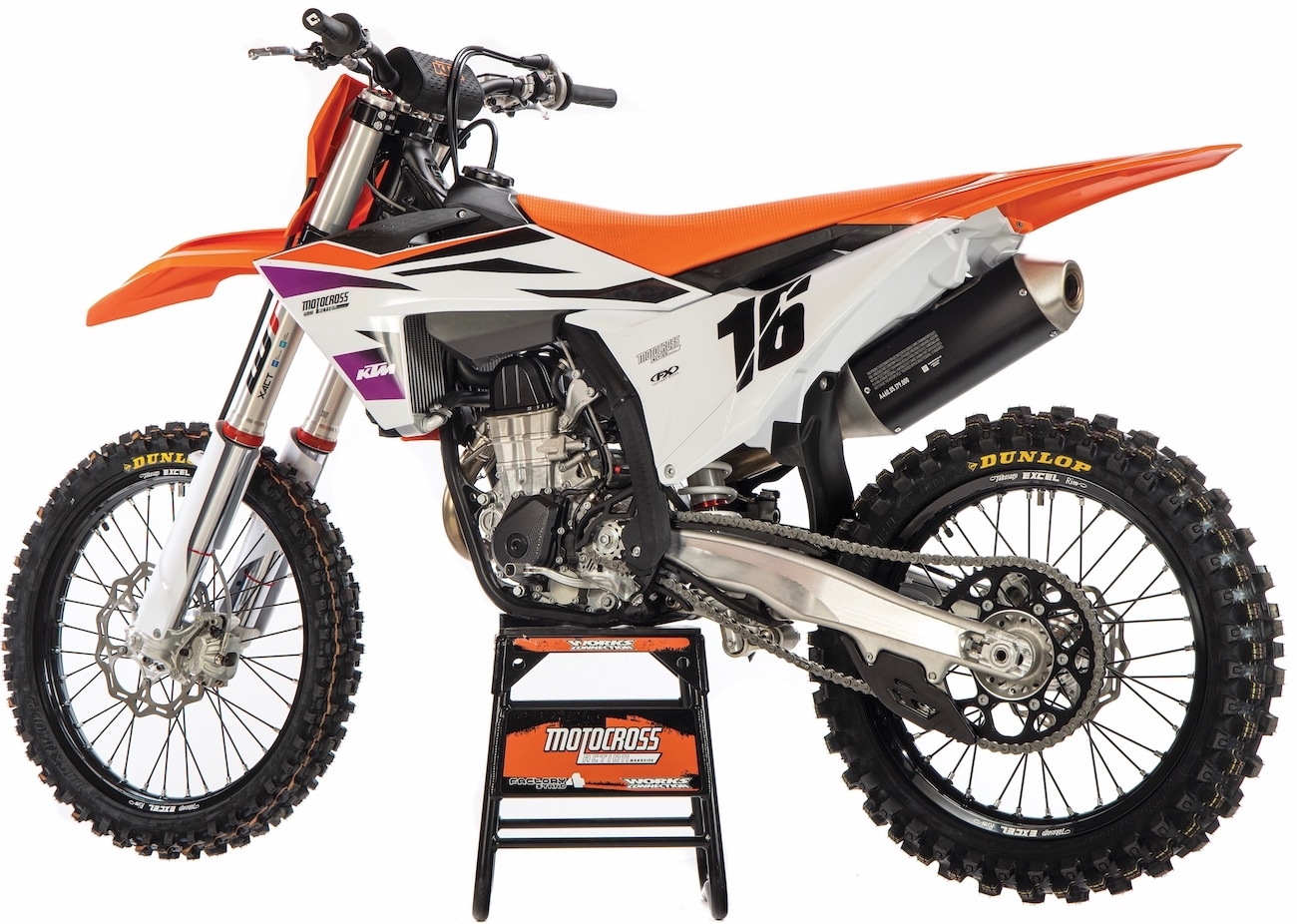
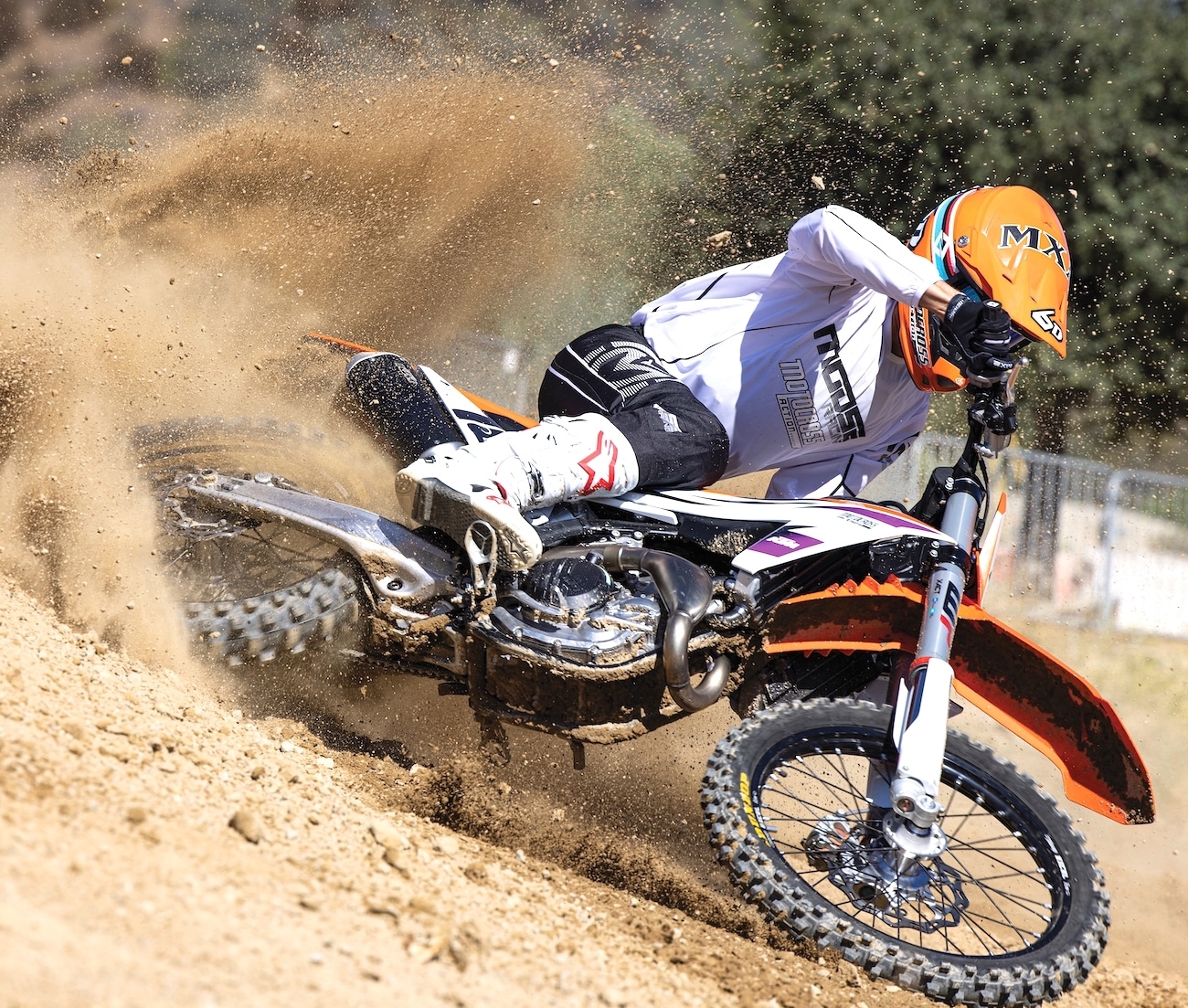





Comments are closed.